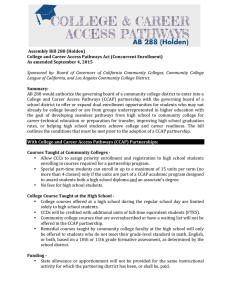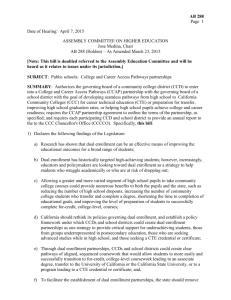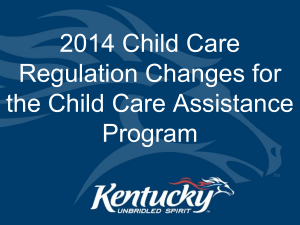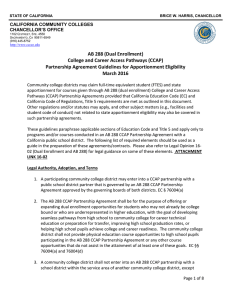education - LegTrack
advertisement
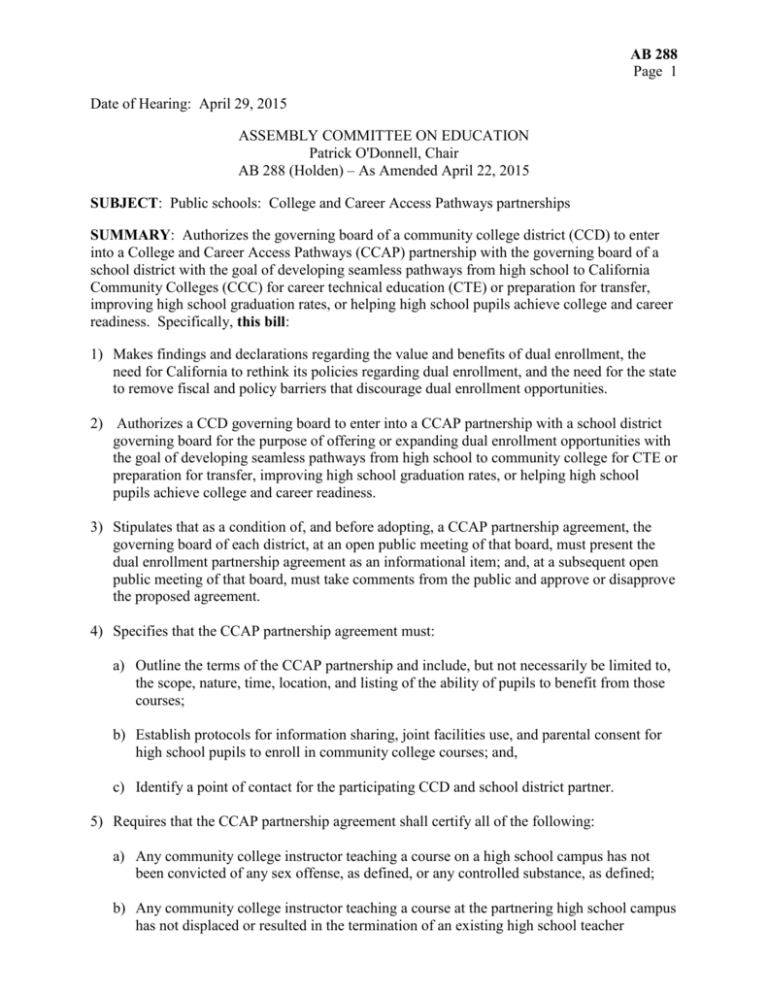
AB 288 Page 1 Date of Hearing: April 29, 2015 ASSEMBLY COMMITTEE ON EDUCATION Patrick O'Donnell, Chair AB 288 (Holden) – As Amended April 22, 2015 SUBJECT: Public schools: College and Career Access Pathways partnerships SUMMARY: Authorizes the governing board of a community college district (CCD) to enter into a College and Career Access Pathways (CCAP) partnership with the governing board of a school district with the goal of developing seamless pathways from high school to California Community Colleges (CCC) for career technical education (CTE) or preparation for transfer, improving high school graduation rates, or helping high school pupils achieve college and career readiness. Specifically, this bill: 1) Makes findings and declarations regarding the value and benefits of dual enrollment, the need for California to rethink its policies regarding dual enrollment, and the need for the state to remove fiscal and policy barriers that discourage dual enrollment opportunities. 2) Authorizes a CCD governing board to enter into a CCAP partnership with a school district governing board for the purpose of offering or expanding dual enrollment opportunities with the goal of developing seamless pathways from high school to community college for CTE or preparation for transfer, improving high school graduation rates, or helping high school pupils achieve college and career readiness. 3) Stipulates that as a condition of, and before adopting, a CCAP partnership agreement, the governing board of each district, at an open public meeting of that board, must present the dual enrollment partnership agreement as an informational item; and, at a subsequent open public meeting of that board, must take comments from the public and approve or disapprove the proposed agreement. 4) Specifies that the CCAP partnership agreement must: a) Outline the terms of the CCAP partnership and include, but not necessarily be limited to, the scope, nature, time, location, and listing of the ability of pupils to benefit from those courses; b) Establish protocols for information sharing, joint facilities use, and parental consent for high school pupils to enroll in community college courses; and, c) Identify a point of contact for the participating CCD and school district partner. 5) Requires that the CCAP partnership agreement shall certify all of the following: a) Any community college instructor teaching a course on a high school campus has not been convicted of any sex offense, as defined, or any controlled substance, as defined; b) Any community college instructor teaching a course at the partnering high school campus has not displaced or resulted in the termination of an existing high school teacher AB 288 Page 2 teaching the same course on that high school campus; c) A qualified high school teacher teaching a course offered for college credit at a high school campus has not displaced or resulted in the termination of an existing community college faculty member teaching the same course at the partnering community college campus; d) Both the CCD and the school district partners comply with local collective bargaining agreements and all state and federal reporting requirements regarding the qualifications of the faculty member or teacher teaching a CCAP partnership course offered for high school credit; e) Which participating district will be the employer of record for purposes of assignment monitoring and reporting to the county office of education and which participating district will assume reporting responsibilities pursuant to applicable federal teacher quality mandates; and f) Remedial courses taught by community college faculty at a partnering high school campus shall be offered only to high school students who test as non-proficient in mathematics, English or both on a formative assessment in grade 10 or 11, as determined by the partnering school district. 6) Specifies that a copy of the CCAP partnership agreement must be filed with the CCCCO and the California Department of Education before the start of the CCAP partnership. 7) Specifies that a CCD participating in a CCAP partnership shall not provide physical education course opportunities to high school pupils, as specified. 8) Specifies that a high school pupil enrolled in a course offered through the CCAP partnership cannot be charged any fee that is prohibited, as specified. 9) Specifies that a CCD participating in a CCAP partnership may assign priority for enrollment and course registration to a pupil seeking to enroll in a community college course that is required for the pupil's CCAP partnership program that is equivalent to the priority assigned to a pupil attending a middle college high school, as specified. 10) Specifies that a CCD may limit enrollment in a community college course solely to eligible high school students if the course is offered at a high school campus during the regular school day and the community college course is offered pursuant to a CCAP agreement. 11) Provides that a CCD conducting a closed course on a high school campus, as specified, shall be credited with those units of full-time equivalent students (FTES) attributable to the attendance of eligible high school pupils. 12) Specifies that a CCD may allow a special part-time student participating in a CCAP partnership agreement to enroll in up to a maximum of 15 units per term if all of the following circumstances are satisfied: a) The units constitute no more than four community college courses per term; AB 288 Page 3 b) The units are part of an academic program that is part of a CCAP; and, c) The units are part of an academic program that is designed to award students both a high school diploma and an associate's degree. 13) Provides that the governing board of a CCD participating in a CCAP partnership agreement may, in whole or part, exempt special part-time students, as specified, from fee requirements, as specified. 14) Provides that a district shall not receive a state allowance or apportionment for an instructional activity for which the partnering district has been, or shall be, paid an allowance or apportionment. 15) Provides that attendance of a high school pupil at a community college as a special part-time or full-time student, as specified, is authorized attendance for which the community college shall be credited or reimbursed, provided that no school district has received reimbursement for the same instructional activity. 16) Provides that for each CCAP partnership agreement entered into, the affected CCD and the school district shall annually report to the CCCCO all of the following information: a) Total number of high school pupils by school site enrolled in each CCAP partnership; b) Total number of community college courses by course category and type and by school site enrolled in by CCAP partnership participants; c) Total number and percentage of successful course completions, by course category and type and by school site, of CCAP partnership participants; d) Total number of FTES generated by CCAP partnership CCD participants; and e) An evaluation of the CCAP partnerships and, based upon the date collected, recommendations for program improvement, including, but not necessarily limited to, the need for additional student assistance or academic resources to ensure the overall success of the CCAP partnerships. 17) Requires the CCAP partnership report to the CCCCO to be transmitted to the Legislature, Director of Finance (DOF), and the State Superintendent of Public Instruction (SPI). 18) Provides that a community college district that violates this article, including, but limited to, any restriction imposed by the board of governors pursuant to this article, shall be subject to restrictions on interdistrict transfer. EXISTING LAW: 1) Authorizes the governing board of a school district, upon recommendation of the principal of a student’s school of attendance, and with parental consent, to authorize a student who would AB 288 Page 4 benefit from advanced scholastic or vocational work to attend a community college as a special part-time or full-time student. 2) Prohibits a pupil enrolled in a public school from being required to pay a pupil fee for participation in an educational activity; and, specifies that all of the following requirements apply to the prohibition: a) All supplies, materials, and equipment needed to participate in educational activities shall be provided to pupils free of charge; b) A fee waiver policy shall not make a pupil fee permissible; c) School districts and schools shall not establish a two-tier educational system by requiring a minimal educational standard and also offering a second, higher educational standard that pupils may only obtain via payment of a fee or purchase of additional supplies that the school district does not provide; and, d) A school district or school shall not offer course credit or privileges related to educational activities in exchange for money or donations of goods or services from a pupil or a pupil’s parents or guardians, and a school district or school shall not remove course credit or privileges related to educational activities, or otherwise discriminate against a pupil, because the pupil or the pupil’s parents or guardians did not or will not provide money or donations of goods or services to the school district or school (EC Section 49011). 3) Requires the CCC Chancellor’s Office to report to the Department of Finance and Legislature annually on the amount of FTES claimed by each CCC district for high school pupils enrolled in non-credit, non-degree applicable, and degree applicable courses; and provides that, for purposes of receiving state apportionments, CCC districts may only include high school students within the CCC district’s report on FTES if the students are enrolled in courses that are open to the general public, as specified. Additionally, current law requires the governing board of a CCC district to assign a low enrollment priority to special part-time or full-time students in order to ensure that these students do not displace regularly admitted community college students (EC Sections 76001 and 76002). FISCAL EFFECT: Unknown COMMENTS: Concurrent and dual enrollment background. According to New Directions for Community Colleges, no. 169, Spring 2015, the practice for offering college courses to high school students stems from local practice in many states and was initiated between CCDs and local school districts, but the practice proceeded without clear state policy guidelines, regulations, or direction; resulting in variation in local practice. Some states, such as Minnesota, as far back as the 1980s, were early adopters of state dual credit policies, whereby their state policies provided a framework for offering college courses to high school students and the students receiving both college and high school credit for some of their courses. Concurrent enrollment provides pupils the opportunity to enroll in college courses and earn college credit while still enrolled in high school. Currently, a pupil is allowed to concurrently enroll in a CCC as a "special admit" while still attending high school, if the pupil's school district AB 288 Page 5 determines that the pupil would benefit from "advanced scholastic or vocational work." Specialadmit students have typically been advanced pupils wanting to take more challenging coursework or pupils who come from high schools where Advanced Placement or honors courses are not widely available. Additionally, programs such as middle college high schools and early college high schools use concurrent enrollment to offer instructional programs for atrisk pupils that focus on college preparatory curricula. These programs are developed through partnerships between a school district and a CCC. During summer session at a CCC, principals are limited to recommending no more than 5% of their pupils in each grade level to enroll at a CCC during a summer session. Existing law provides certain exemptions to this process (as aforementioned in current law above). These exemptions expired on January 1, 2014. According to a February 2014 report by Education Commission of the States (ECS), the number of U. S. public high schools offering concurrent enrollment programs is growing, with 82% providing such opportunities in 2011-12. Academic research and state experience highlight the benefits of concurrent enrollment programs for improving college rates, particularly for minority and/or low-income students. Additionally, ECS finds that with the possible exception of the state of Massachusetts, minority and/or low-income students tend to be underrepresented in statewide concurrent enrollment programs. Purpose of this bill. The author states, "Gradually more students are entering community colleges and some CSUs [California State University] assessing below college-level. Consequently, more courses are being offered on their respective campuses to prepare students for college level coursework." The author contends that, "This measure will increase the accessibility of concurrent enrollment programs in order to continue to achieve the goal of helping low achieving students integrate into a college environment, increase the likelihood a degree program will be completed, decrease the length of time to complete a degree program, and stimulate interest in higher education among high school students." How many? According to the CCCCO's statutorily required report on special admit enrollments: 26,604 (the most recent data available to date) special admit students were claimed systemwide, in summer 2013, with 22,432 of the students successfully completing and passing their courses. The summer 2013 numbers have slightly increased when compared to the previous last couple of years; however, the 2013 numbers remain significantly lower when compared to summer 2007, when of the 68,708 special admit students claimed systemwide, 53,387 successfully completed and passed their courses. Double-dipping? There is a common perception that concurrent enrollment courses require a state to "pay twice" for a student to take a single course. However, according to ECS, "If the dual enrollment opportunity is strong, rather than paying twice, states are paying earlier." ECS concludes that the state is consolidating two payments into one if the community college course that the high school pupil takes is transferable to the postsecondary institution where he or she later enrolls. To address this issue, this measure specifies that a district shall not receive a state allowance or apportionment for an instructional activity for which the partnering district has been, or shall be, paid an allowance or apportionment Highly qualified teachers. Federal law requires all states to take the following actions with regard to "highly qualified teachers:" AB 288 Page 6 Measure the extent to which all students have highly qualified teachers, particularly minority and disadvantaged students; Adopt goals and plans to ensure all teachers are highly qualified; and Publicly report plans and progress in meeting teacher quality goals. In order to be designated as highly qualified, a teacher must be certificated. However, the highly qualified teacher requirement does not apply to community college faculty. This bill avoids the federal requirement by allowing the community college district to be designated as the employer of record. Students who are concurrently enrolled under existing law can earn high school credit as well as college credit for courses taken. Under existing law, however, those courses are taught at a college campus and the number of students who may be concurrently enrolled is limited. This bill allows courses to be taken for dual credit at a high school and does not impose a limit on the number of students who can be concurrently enrolled. Under the partnership, courses for high school credit can be taught by a community college instructor who is not credentialed, which moves us in the opposition direction of federal requirement. Certification means a teacher has not only the subject matter knowledge, but also the pedagogical training and experience needed to effectively teach high school-aged students. While concurrent enrollment offers many advantages, the committee may wish to consider how far California should go in relaxing the requirement that courses for high school credit be taught by certificated teachers. REGISTERED SUPPORT / OPPOSITION: Support Academic Senate for the California Community Colleges California Catholic Conference, Inc. California Chamber of Commerce California Community Colleges Chancellor's Office California Edge Coalition California School Boards Association Chaffey College Children Now College of the Siskiyous Community College League of California Compton Unified School District Design Science Early College High School Boosters Club EdVoice Freemont Union High School District Gentrain Society Irvine Valley College Kern Community College District Los Angeles Community College District Los Angeles Unified School District Los Rios Community College District Napa Valley Community College District North Orange County Community College District Monterey Peninsula Community College District AB 288 Page 7 Orange County Business Council Pasadena Community College District Peralta Community College District Rural County Representatives of California San Bernardino Community College District San Diego Community College District San Diego Unified School District San Francisco Community College District Santa Rosa Junior College Saddleback College South Orange County Community College District West Kern Community College District Yuba Community College District Opposition None on file Analysis Prepared by: Rick Pratt / ED. / (916) 319-2087



